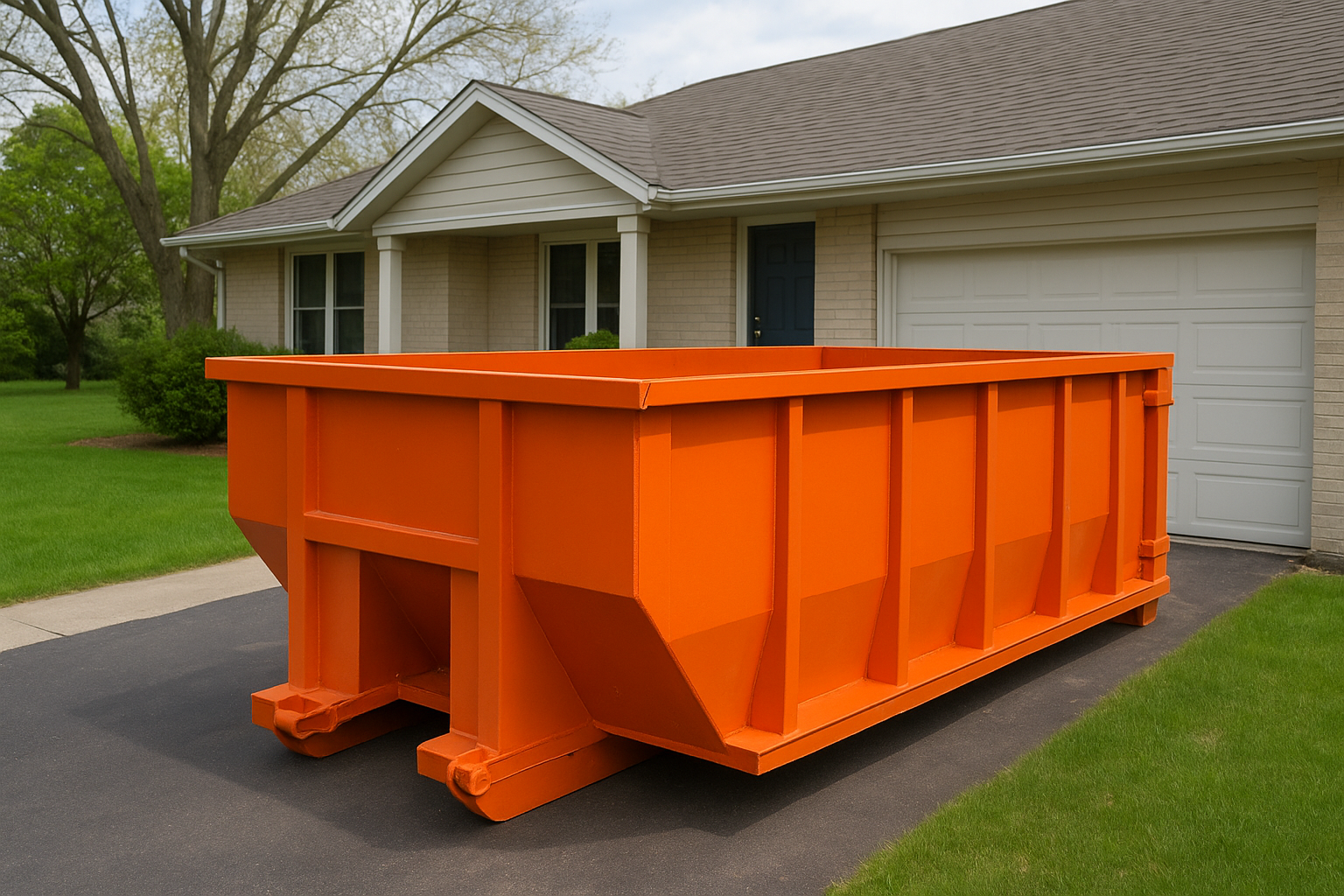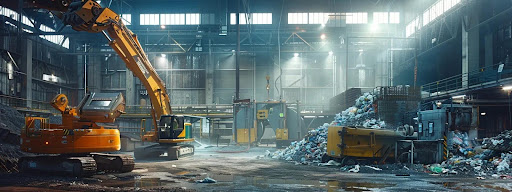
Sustainable Construction Waste Solutions: Exploring the Future of Construction Waste Removal
By BKThemes
Introduction Construction waste management is evolving rapidly amid increasing environmental concerns and stricter governmental regulations. With urban expansion and numerous demolition projects, efficient removal and recycling of construction debris have become paramount. Companies face heavy fines and reputational risks if waste is not handled properly, while sustainable practices yield cost savings and improve community relations. This article examines the latest trends and innovations in construction waste removal with a focus on sustainability, advanced recycling technologies, on-site strategies, eco-friendly disposal methods, and future technology trends. The discussion is structured around key questions to help business owners, contractors, and waste management professionals understand how integrated waste solutions can reduce costs, meet regulatory requirements, and support a circular economy.
What Are the Latest Trends in Construction Waste Removal?
The trends in construction waste removal emphasize sustainability and efficiency. Companies increasingly integrate state-of-the-art recycling processes, proactive waste audits, and advanced digital tracking systems to reduce waste and promote resource recovery. With zero waste goals and enhanced operational transparency, digital solutions and automation ensure that every particle —from tile fragments to engineered wood waste—is processed in an environmentally friendly manner.
How Is Sustainability Shaping Construction Waste Management?
Sustainability is pivotal in mitigating the carbon footprint of construction by promoting responsible disposal and recycling practices. Strategies include waste minimization, reusing building components, and integrating renewable energy in recycling operations. For example, on-site sorting and using recycled concrete as aggregate help lower disposal costs. Sensor-based sorting systems reduce contamination and increase the recovery of reusable materials, with some companies achieving up to 35% reductions in landfill waste while also curbing the release of harmful organic compounds and particulate matter.
What Innovations Are Driving Waste Reduction on Construction Sites?
Innovative technologies such as robotic and smart sorting systems are transforming waste reduction on sites. Machine learning algorithms distinguish between concrete, metals, plastics, and more, while mobile apps and digital dashboards provide real-time monitoring of waste generation and disposal. Data-driven approaches lower disposal costs and enhance regulatory compliance. Advanced recycling facilities now capture dust and leachate during transport and processing, maintaining a closed-loop system where demolition waste becomes valuable resources for new projects.
Why Is Circular Economy Important for Construction Waste?
A circular economy reintroduces waste materials as raw inputs, moving away from a “take, make, dispose” model. In construction, this approach minimizes environmental impacts and reduces raw material procurement costs by maximizing the reuse of components such as gravel, mortar, and engineered wood. Practices like design for deconstruction and the inclusion of recycled materials in new builds not only reduce the need for virgin resources but also lower carbon emissions and support long-term economic resilience. construction demolition recycling
How Do Advanced Construction Waste Recycling Technologies Work?
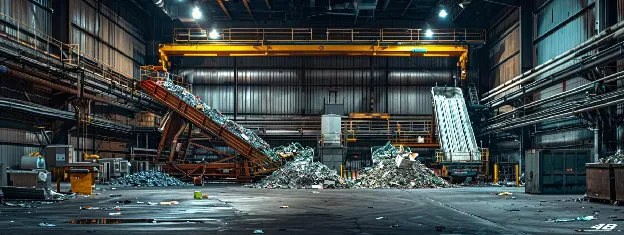
Advanced recycling technologies use energy-efficient methods and digital systems to maximize the value extracted from construction waste. Facilities sort debris into categories like concrete, metals, plastics, and wood using automated processes. Innovations such as AI-driven optical sorting and sensor-based separation significantly enhance the purity of recycled materials, reducing both transport and processing costs and benefiting contractors and communities alike. For more information, check out the construction demolition recycling blog.
What Are the Key Technologies for Sorting and Recycling Construction Waste?
Key technologies include: - Optical Sorting Machines: Utilize near-infrared spectroscopy to differentiate materials at a molecular level. - Magnetic Separators: Efficiently extract ferrous metals using strong magnetic fields. - Air Classifiers: Separate materials based on weight and density to isolate aggregates. - Sensor-Enhanced Screening Systems: Identify contaminants like polyvinyl chloride residues. Integrated into a cohesive system, these technologies enable real-time monitoring and improvement of recycling efficiency, sometimes boosting recovery rates by up to 40% .
How Do Advanced Recycling Facilities Process Construction Materials?
Recycling facilities use mechanical and digital processes to convert waste into usable materials . Debris is first sorted into large fractions with shredders and screens. Subsequent refinement with optical sorters, magnetic separators, and flotation units segregates the waste into specific categories. The final phase typically involves crushing and granulating materials such as concrete and asphalt into recycled aggregates, all while monitoring dust emissions and leachate production to ensure quality and minimize environmental impact. Construction and demolition debris material
What Role Do Partnerships Play in Enhancing Recycling Efficiency?
Collaboration among waste management companies, construction firms, and government agencies is key to advancing recycling efficiency. Shared investments in advanced recycling technologies, modular recycling units for on-site deconstruction, and streamlined regulatory frameworks all contribute to faster adoption of sustainable practices. Partnerships also provide shared data resources that inform strategies to lower carbon dioxide emissions and enhance resource recovery.
What Are Effective Construction Site Waste Management Strategies?
Effective waste management on construction sites relies on proactive planning, advanced technologies, and rigorous auditing practices. Comprehensive waste management plans include detailed sorting protocols, recycling methods, and safeguard measures for hazardous materials. These plans not only reduce environmental impact but also yield cost benefits, while regular audits ensure compliance with local state regulations .
How Can Waste Audits Improve Construction Waste Management?
Waste audits are critical tools for understanding the types and volumes of waste generated on-site. By analyzing waste streams and pinpointing inefficiencies, audits help firms adjust practices based on quantifiable metrics—such as kilograms of debris per square meter—and benchmark improvements. Regular audits have been shown to reduce overall waste generation by up to 25% by enabling better resource allocation and focused staff training .
What Are Best Practices for on-Site Waste Sorting?
Best practices include: - Clear labeling of waste containers. - Regular training for staff on sorting protocols. - Dedicated sorting stations with color-coded bins. - Utilization of digital monitoring systems to track sorting efficiency. These measures simplify recycling processes, reduce contamination, and support zero waste objectives, while also minimizing environmental hazards like leachate release and air pollution .
How Does Regulatory Compliance Influence Waste Management?
Compliance with local, state, and national regulations drives the adoption of sustainable waste management practices. Regulations mandate detailed waste reporting and impose fines for non-compliance, pushing contractors to invest in digital monitoring tools. Such frameworks not only help avoid penalties but also secure government incentives for redeveloping recycled materials , boosting a company’s reputation as a responsible operator.
Which Eco-Friendly Waste Disposal Methods Are Emerging in Construction?
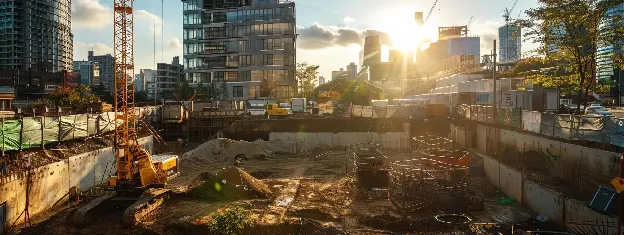
New eco-friendly waste disposal methods move away from traditional landfills and incineration by focusing on on-site deconstruction, advanced composting of organic waste, and renewable energy-powered recycling solutions. These approaches are specifically designed to minimize carbon dioxide and other harmful emissions while ensuring that valuable materials are repurposed effectively. Globally, these eco-friendly techniques are aligning with sustainable management construction and reducing both environmental and operational costs.
What Are Sustainable Alternatives to Landfill Disposal?
Sustainable alternatives include: - Recycling Facilities: Process concrete, metals, and plastics into reusable raw materials. - Composting Systems: Transform organic waste into nutrient-rich soil amendments. - Waste-to-Energy Plants: Convert non-recyclable materials into electricity using advanced combustion technologies. - Deconstruction: Systematically dismantles buildings to salvage materials, maximizing reuse and reducing landfill volumes. These alternatives promote a circular economy and help lower overall waste management expenses.
How Do Eco-Friendly Methods Reduce Environmental Impact?
Eco-friendly practices reduce environmental impact by minimizing greenhouse gas emissions, lowering energy consumption, and preventing the release of hazardous substances. For instance, recycling concrete cuts down on carbon dioxide emissions linked to cement production, while composting organic waste prevents methane generation in anaerobic landfill conditions. Waste-to-energy processes also reduce fossil fuel consumption by converting wasted energy into electricity.
What Are the Cost Benefits of Eco-Friendly Waste Disposal?
Adopting eco-friendly waste methods offers significant cost benefits. Lower disposal fees, reduced material costs through recycling, and government incentives such as tax rebates help companies save money. Additionally, revenues from sold recycled materials and reduced operational costs from efficient energy use further improve overall financial performance in a competitive construction market .
How Will Future Technologies Transform Construction Waste Removal?
Future technologies will transform waste removal by integrating automation, artificial intelligence (AI), and next-generation material science into waste management practices. These innovations will streamline waste identification, sorting, and processing, significantly reducing manual intervention and errors. Planned advancements include smart sensors, blockchain for waste tracking, and advanced robotics capable of operating in hazardous conditions, which will collectively enhance process efficiency, lower energy consumption, and support a transition toward sustainable waste management systems.
What Role Will Automation and AI Play in Waste Management?
Automation and AI will be central, processing vast amounts of waste data in real time and enabling near-perfect sorting accuracy. AI algorithms can predict waste generation patterns, optimize transport logistics, and even suggest design modifications to minimize debris. Automated systems with high-resolution sensors ensure materials are correctly identified and routed, reducing labor costs and human error while improving recycling yields .
How Will New Materials Affect Waste Removal Practices?
Innovative construction materials—such as engineered wood composites, recycled polymers, and bio-based concretes—are designed for durability and recyclability but alter the composition of waste streams. Waste management facilities must update sorting protocols and invest in specialized equipment to effectively process these new materials. Such adaptations ensure that as construction materials evolve, waste removal practices remain efficient and environmentally sustainable.
What Are the Emerging Trends in Waste Reporting and Sustainability Metrics?
Digital reporting platforms and standardized sustainability metrics are reshaping waste management. Real-time analytics from sensor-equipped recycling bins and mobile tracking systems provide comprehensive dashboards that monitor waste generation, recycling rates, and cost savings. Metrics now include greenhouse gas reductions and energy savings, offering competitive advantages by demonstrating a company’s commitment to sustainable practices and enabling smarter decision-making.
Why Should Construction Companies Invest in Sustainable Waste Solutions?
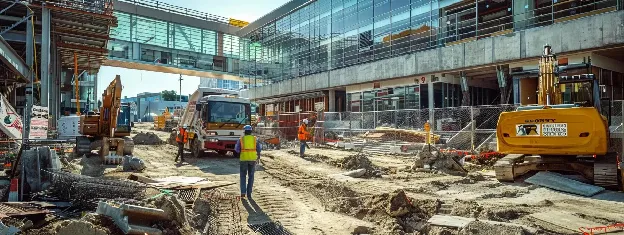
Investing in sustainable waste solutions is a strategic imperative that reduces environmental impact while creating long-term cost savings and enhancing brand reputation. Optimized resource use and lower disposal fees, combined with government incentives, help companies meet regulatory requirements and appeal to a market increasingly favoring environmentally responsible practices. As consumer awareness grows, sustainability becomes a key differentiator in the construction industry.
How Does Sustainable Waste Management Enhance Brand Reputation?
Eco-friendly waste management demonstrates a company’s commitment to reducing carbon footprints and promoting a circular economy. Such practices foster improved relationships with communities, government agencies, and investors. Certifications like LEED and BREEAM further enhance corporate image and market positioning, attracting more clients and strengthening competitive advantage .
What Are the Financial Incentives for Sustainable Waste Practices?
Financial incentives include direct cost savings from lower landfill fees, reduced material procurement costs via recycling, and eligibility for green subsidies or tax credits. Government rebates and increased operational efficiencies further bolster the economic case for investing in sustainable waste solutions .
How Can Consulting Services Support Sustainable Waste Management?
Consulting services provide expert guidance on best practices and innovative technologies, helping companies develop tailored waste management plans that meet regulatory standards. By optimizing processes, improving material recovery, and leveraging digital monitoring tools, consultants help reduce inefficiencies and achieve significant cost savings while advancing sustainability goals .
What Are the Challenges and Opportunities in the Future of Construction Waste Removal?
The future of construction waste removal is defined by both challenges and opportunities. Rapid urbanization, evolving regulations, and diverse waste streams pose significant hurdles, including high capital costs and the need for continual innovation. However, the drive toward sustainable construction creates substantial opportunities for enhanced waste management. Technological advancements and industry collaborations promise improved efficiency, regulatory compliance, and competitive advantages for early adopters of innovative waste recycling systems .
What Are the Main Barriers to Adopting Sustainable Waste Solutions?
High upfront investment costs, technological complexity, and resistance to change among established construction practices are key barriers. Many smaller companies face challenges in funding advanced recycling technologies and lack standardized procedures for new materials. As digital tools become more accessible and sustainable practices gain mainstream acceptance, these barriers are expected to diminish.
How Can Industry Collaboration Overcome Waste Management Challenges?
Collaborative ventures among construction firms, recycling companies, and technology providers foster innovation and cost-sharing. Shared research, standardized reporting, and pooling of resources can lower fixed costs and encourage broader adoption of sustainable waste management practices, driving industry-wide improvements .
What Opportunities Exist for Growth in Construction Waste Recycling?
Opportunities for growth are abundant. Rising demand for recycled construction materials, automation in sorting processes, and expanded deconstruction practices are creating new revenue streams. As regulatory pressures and market demands for sustainability increase, early adopters of advanced recycling systems are well-positioned to capture significant market share.
List of Key Construction Waste Recycling Technologies and Benefits
- Optical Sorting Systems – High Accuracy in Material Segregation Uses near-infrared spectroscopy to differentiate materials, enhancing recyclables recovery and reducing contamination.
- Magnetic Separators – Efficient Metal Recovery Utilizes strong magnetic fields to extract ferrous metals, increasing the purity of recycled metals.
- Air Classifiers – Enhanced Separation by Density Separates materials by weight to isolate aggregates from finer waste, boosting recycling yields.
- Smart Sensor Integration – Real-Time Waste Monitoring Employs sensors and digital dashboards for immediate operational insights and improved sorting efficiency.
- Automated Shredders and Crushers – Optimized Debris Reduction Mechanically reduces large waste into manageable pieces for easier processing, lowering transport and processing costs.
Table: Comparison of Recycling Technologies in Construction Waste Management
Show original
Before delving further into recycling opportunities, consider this table summarizing key technologies :
| Technology | Key Attribute | Benefit | Typical Recovery Improvement |
|---|---|---|---|
| Optical Sorting Systems | Near-infrared spectroscopy | High accuracy in material separation | Up to 40% |
| Magnetic Separators | Strong magnetic fields | Efficient recovery of ferrous metals | Up to 35% |
| Air Classifiers | Density-based separation | Improved isolation of aggregates | Up to 30% |
| Smart Sensor Systems | Real-time monitoring | Enhanced operational efficiency | Up to 25% |
| Automated Shredders | Mechanical reduction | Reduced size for easier processing | Up to 20% |
Frequently Asked Questions
Our white label link building services are the best option for agencies looking for quality, scalability, and convenience. We create SEO optimized, fresh content that performs well in search rankings and boosts your clients’ site authority. All of our backlinks come from authoritative publishers . We’ll secure the quantity you need and in the right time frame.
Q: What sustainable alternatives exist to traditional landfill disposal in construction? A: Recycling facilities , composting systems, waste-to-energy plants, and systematic deconstruction are viable alternatives that promote resource efficiency and lower carbon emissions. Sustainable management
Q: How does automation improve construction waste management? A: Automation, including AI-driven sorting and real-time monitoring, reduces human error, increases recycling yields, and cuts overall costs .
Circular economy changes your waste
Q: What role does a circular economy play in modern construction waste strategies? A: It minimizes waste by reusing and recycling debris as raw materials, reducing the reliance on virgin resources and lowering environmental impacts.
Q: Are there financial incentives available for companies that adopt sustainable waste management practices? A: Yes, many governments offer tax credits , rebates, and subsidies, while improved operational efficiencies further enhance long-term financial benefits.
Q: How do waste audits contribute to better waste management at construction sites? A: They provide detailed data on waste types and volumes, allowing companies to identify inefficiencies and implement targeted improvements that can reduce waste generation by up to 25%. waste management
waste management in construction
Q: What future trends can we expect in construction waste removal? A: Increased automation and AI integration, broader adoption of smart sensor technologies, and more collaborative industry partnerships will transform waste management, supported by advanced material science and digital reporting .
Final Thoughts
Sustainable construction waste removal is both an environmental necessity and an economic opportunity. Technological innovations and efficient waste sorting practices allow construction firms to improve compliance, reduce costs, and enhance brand reputation. With deeper industrial collaboration and automated waste management systems on the horizon, adopting these sustainable solutions today will equip companies to meet future challenges while contributing to a greener, more resilient built environment.every particle
Sustainable Construction Waste Solutions: Exploring the Future of Construction Waste Removal
Introduction Construction waste management is evolving rapidly amid increasing environmental concerns and stricter governmental regulations. With urban expansion and numerous demolition projects, efficient removal and recycling of construction debris have become paramount. Companies face heavy fines and reputational risks if waste is not handled properly, while sustainable practices yield cost savings and improve community relations. This article examines the latest trends and innovations in construction waste removal with a focus on sustainability, advanced recycling technologies, on-site strategies, eco-friendly disposal methods, and future technology trends. The discussion is structured around key questions to help business owners, contractors, and waste management professionals understand how integrated waste solutions can reduce costs, meet regulatory requirements, and support a circular economy.
What Are the Latest Trends in Construction Waste Removal?
The trends in construction waste removal emphasize sustainability and efficiency. Companies increasingly integrate state-of-the-art recycling processes, proactive waste audits, and advanced digital tracking systems to reduce waste and promote resource recovery. With zero waste goals and enhanced operational transparency, digital solutions and automation ensure that
—from tile fragments to engineered wood waste—is processed in an environmentally friendly manner.
How Is Sustainability Shaping Construction Waste Management?
Sustainability is pivotal in mitigating the carbon footprint of construction by promoting responsible disposal and recycling practices. Strategies include waste minimization, reusing building components, and integrating renewable energy in recycling operations. For example, on-site sorting and using recycled concrete as aggregate help lower disposal costs. Sensor-based sorting systems reduce contamination and increase the recovery of reusable materials, with some companies achieving up to 35% reductions in landfill waste while also curbing the release of harmful organic compounds and particulate matter.
What Innovations Are Driving Waste Reduction on Construction Sites?
Innovative technologies such as robotic and smart sorting systems are transforming waste reduction on sites. Machine learning algorithms distinguish between concrete, metals, plastics, and more, while mobile apps and digital dashboards provide real-time monitoring of waste generation and disposal. Data-driven approaches lower disposal costs and enhance regulatory compliance. Advanced recycling facilities now capture dust and leachate during transport and processing, maintaining a closed-loop system where demolition waste becomes valuable resources for new projects.
Why Is Circular Economy Important for Construction Waste?
A circular economy reintroduces waste materials as raw inputs, moving away from a “take, make, dispose” model. In construction, this approach minimizes environmental impacts and reduces raw material procurement costs by maximizing the reuse of components such as gravel, mortar, and engineered wood. Practices like design for deconstruction and the inclusion of recycled materials in new builds not only reduce the need for virgin resources but also lower carbon emissions and support long-term economic resilience. construction demolition recycling
How Do Advanced Construction Waste Recycling Technologies Work?

Advanced recycling technologies use energy-efficient methods and digital systems to maximize the value extracted from construction waste. Facilities sort debris into categories like concrete, metals, plastics, and wood using automated processes. Innovations such as AI-driven optical sorting and sensor-based separation significantly enhance the purity of recycled materials, reducing both transport and processing costs and benefiting contractors and communities alike. For more information, check out the construction demolition recycling blog.
What Are the Key Technologies for Sorting and Recycling Construction Waste?
Key technologies include: - Optical Sorting Machines: Utilize near-infrared spectroscopy to differentiate materials at a molecular level. - Magnetic Separators: Efficiently extract ferrous metals using strong magnetic fields. - Air Classifiers: Separate materials based on weight and density to isolate aggregates. - Sensor-Enhanced Screening Systems: Identify contaminants like polyvinyl chloride residues. Integrated into a cohesive system, these technologies enable real-time monitoring and improvement of recycling efficiency, sometimes boosting recovery rates by up to 40% .
How Do Advanced Recycling Facilities Process Construction Materials?
Recycling facilities use mechanical and digital processes to convert waste into usable materials . Debris is first sorted into large fractions with shredders and screens. Subsequent refinement with optical sorters, magnetic separators, and flotation units segregates the waste into specific categories. The final phase typically involves crushing and granulating materials such as concrete and asphalt into recycled aggregates, all while monitoring dust emissions and leachate production to ensure quality and minimize environmental impact. Construction and demolition debris material
What Role Do Partnerships Play in Enhancing Recycling Efficiency?
Collaboration among waste management companies, construction firms, and government agencies is key to advancing recycling efficiency. Shared investments in advanced recycling technologies, modular recycling units for on-site deconstruction, and streamlined regulatory frameworks all contribute to faster adoption of sustainable practices. Partnerships also provide shared data resources that inform strategies to lower carbon dioxide emissions and enhance resource recovery.
What Are Effective Construction Site Waste Management Strategies?
Effective waste management on construction sites relies on proactive planning, advanced technologies, and rigorous auditing practices. Comprehensive waste management plans include detailed sorting protocols, recycling methods, and safeguard measures for hazardous materials. These plans not only reduce environmental impact but also yield cost benefits, while regular audits ensure compliance with local and state regulations.
How Can Waste Audits Improve Construction Waste Management?
Waste audits are critical tools for understanding the types and volumes of waste generated on-site. By analyzing waste streams and pinpointing inefficiencies, audits help firms adjust practices based on quantifiable metrics—such as kilograms of debris per square meter—and benchmark improvements. Regular audits have been shown to reduce overall waste generation by up to 25% by enabling better resource allocation and focused staff training .
What Are Best Practices for on-Site Waste Sorting?
Best practices include: - Clear labeling of waste containers. - Regular training for staff on sorting protocols. - Dedicated sorting stations with color-coded bins. - Utilization of digital monitoring systems to track sorting efficiency. These measures simplify recycling processes, reduce contamination, and support zero waste objectives, while also minimizing environmental hazards like leachate release and air pollution .
How Does Regulatory Compliance Influence Waste Management?
Compliance with local, state, and national regulations drives the adoption of sustainable waste management practices. Regulations mandate detailed waste reporting and impose fines for non-compliance, pushing contractors to invest in digital monitoring tools. Such frameworks not only help avoid penalties but also secure government incentives for redeveloping recycled materials, boosting a company’s reputation as a responsible operator.
Which Eco-Friendly Waste Disposal Methods Are Emerging in Construction?

New eco-friendly waste disposal methods move away from traditional landfills and incineration by focusing on on-site deconstruction, advanced composting of organic waste, and renewable energy-powered recycling solutions. These approaches are specifically designed to minimize carbon dioxide and other harmful emissions while ensuring that valuable materials are repurposed effectively. Globally, these eco-friendly techniques are aligning with sustainable management construction and reducing both environmental and operational costs.
What Are Sustainable Alternatives to Landfill Disposal?
Sustainable alternatives include: - Recycling Facilities: Process concrete, metals, and plastics into reusable raw materials. - Composting Systems: Transform organic waste into nutrient-rich soil amendments. - Waste-to-Energy Plants: Convert non-recyclable materials into electricity using advanced combustion technologies. - Deconstruction: Systematically dismantles buildings to salvage materials, maximizing reuse and reducing landfill volumes. These alternatives promote a circular economy and help lower overall waste management expenses.
How Do Eco-Friendly Methods Reduce Environmental Impact?
Eco-friendly practices reduce environmental impact by minimizing greenhouse gas emissions, lowering energy consumption, and preventing the release of hazardous substances. For instance, recycling concrete cuts down on carbon dioxide emissions linked to cement production, while composting organic waste prevents methane generation in anaerobic landfill conditions. Waste-to-energy processes also reduce fossil fuel consumption by converting wasted energy into electricity.
What Are the Cost Benefits of Eco-Friendly Waste Disposal?
Adopting eco-friendly waste methods offers significant cost benefits. Lower disposal fees, reduced material costs through recycling, and government incentives such as tax rebates help companies save money. Additionally, revenues from sold recycled materials and reduced operational costs from efficient energy use further improve overall financial performance in a competitive construction market .
How Will Future Technologies Transform Construction Waste Removal?
Future technologies will transform waste removal by integrating automation, artificial intelligence (AI), and next-generation material science into waste management practices. These innovations will streamline waste identification, sorting, and processing, significantly reducing manual intervention and errors. Planned advancements include smart sensors, blockchain for waste tracking, and advanced robotics capable of operating in hazardous conditions, which will collectively enhance process efficiency, lower energy consumption, and support a transition toward sustainable waste management systems.
What Role Will Automation and AI Play in Waste Management?
Automation and AI will be central, processing vast amounts of waste data in real time and enabling near-perfect sorting accuracy. AI algorithms can predict waste generation patterns, optimize transport logistics, and even suggest design modifications to minimize debris. Automated systems with high-resolution sensors ensure materials are correctly identified and routed, reducing labor costs and human error while improving recycling yields .
How Will New Materials Affect Waste Removal Practices?
Innovative construction materials—such as engineered wood composites, recycled polymers, and bio-based concretes—are designed for durability and recyclability but alter the composition of waste streams. Waste management facilities must update sorting protocols and invest in specialized equipment to effectively process these new materials. Such adaptations ensure that as construction materials evolve, waste removal practices remain efficient and environmentally sustainable.
What Are the Emerging Trends in Waste Reporting and Sustainability Metrics?
Digital reporting platforms and standardized sustainability metrics are reshaping waste management. Real-time analytics from sensor-equipped recycling bins and mobile tracking systems provide comprehensive dashboards that monitor waste generation, recycling rates, and cost savings. Metrics now include greenhouse gas reductions and energy savings, offering competitive advantages by demonstrating a company’s commitment to sustainable practices and enabling smarter decision-making.
Why Should Construction Companies Invest in Sustainable Waste Solutions?

Investing in sustainable waste solutions is a strategic imperative that reduces environmental impact while creating long-term cost savings and enhancing brand reputation. Optimized resource use and lower disposal fees, combined with government incentives, help companies meet regulatory requirements and appeal to a market increasingly favoring environmentally responsible practices. As consumer awareness grows, sustainability becomes a key differentiator in the construction industry.
How Does Sustainable Waste Management Enhance Brand Reputation?
Eco-friendly waste management demonstrates a company’s commitment to reducing carbon footprints and promoting a circular economy. Such practices foster improved relationships with communities, government agencies, and investors. Certifications like LEED and BREEAM further enhance corporate image and market positioning, attracting more clients and strengthening competitive advantage .
What Are the Financial Incentives for Sustainable Waste Practices?
Financial incentives include direct cost savings from lower landfill fees, reduced material procurement costs via recycling, and eligibility for green subsidies or tax credits. Government rebates and increased operational efficiencies further bolster the economic case for investing in sustainable waste solutions .
How Can Consulting Services Support Sustainable Waste Management?
Consulting services provide expert guidance on best practices and innovative technologies, helping companies develop tailored waste management plans that meet regulatory standards. By optimizing processes, improving material recovery, and leveraging digital monitoring tools, consultants help reduce inefficiencies and achieve significant cost savings while advancing sustainability goals .
What Are the Challenges and Opportunities in the Future of Construction Waste Removal?
The future of construction waste removal is defined by both challenges and opportunities. Rapid urbanization, evolving regulations, and diverse waste streams pose significant hurdles, including high capital costs and the need for continual innovation. However, the drive toward sustainable construction creates substantial opportunities for enhanced waste management. Technological advancements and industry collaborations promise improved efficiency, regulatory compliance, and competitive advantages for early adopters of innovative waste recycling systems .
What Are the Main Barriers to Adopting Sustainable Waste Solutions?
High upfront investment costs, technological complexity, and resistance to change among established construction practices are key barriers. Many smaller companies face challenges in funding advanced recycling technologies and lack standardized procedures for new materials. As digital tools become more accessible and sustainable practices gain mainstream acceptance, these barriers are expected to diminish.
How Can Industry Collaboration Overcome Waste Management Challenges?
Collaborative ventures among construction firms, recycling companies, and technology providers foster innovation and cost-sharing. Shared research, standardized reporting, and pooling of resources can lower fixed costs and encourage broader adoption of sustainable waste management practices, driving industry-wide improvements .
What Opportunities Exist for Growth in Construction Waste Recycling?
Opportunities for growth are abundant. Rising demand for recycled construction materials, automation in sorting processes, and expanded deconstruction practices are creating new revenue streams. As regulatory pressures and market demands for sustainability increase, early adopters of advanced recycling systems are well-positioned to capture significant market share.
List of Key Construction Waste Recycling Technologies and Benefits
- Optical Sorting Systems – High Accuracy in Material Segregation Uses near-infrared spectroscopy to differentiate materials, enhancing recyclables recovery and reducing contamination.
- Magnetic Separators – Efficient Metal Recovery Utilizes strong magnetic fields to extract ferrous metals, increasing the purity of recycled metals.
- Air Classifiers – Enhanced Separation by Density Separates materials by weight to isolate aggregates from finer waste, boosting recycling yields.
- Smart Sensor Integration – Real-Time Waste Monitoring Employs sensors and digital dashboards for immediate operational insights and improved sorting efficiency.
- Automated Shredders and Crushers – Optimized Debris Reduction Mechanically reduces large waste into manageable pieces for easier processing, lowering transport and processing costs.
Table: Comparison of Recycling Technologies in Construction Waste Management
Show original
Before delving further into recycling opportunities, consider this table summarizing key technologies :
| Technology | Key Attribute | Benefit | Typical Recovery Improvement |
|---|---|---|---|
| Optical Sorting Systems | Near-infrared spectroscopy | High accuracy in material separation | Up to 40% |
| Magnetic Separators | Strong magnetic fields | Efficient recovery of ferrous metals | Up to 35% |
| Air Classifiers | Density-based separation | Improved isolation of aggregates | Up to 30% |
| Smart Sensor Systems | Real-time monitoring | Enhanced operational efficiency | Up to 25% |
| Automated Shredders | Mechanical reduction | Reduced size for easier processing | Up to 20% |
Frequently Asked Questions
Our white label link building services are the best option for agencies looking for quality, scalability, and convenience. We create SEO optimized, fresh content that performs well in search rankings and boosts your clients’ site authority. All of our backlinks come from authoritative publishers . We’ll secure the quantity you need and in the right time frame.
Q: What sustainable alternatives exist to traditional landfill disposal in construction? A: Recycling facilities , composting systems, waste-to-energy plants, and systematic deconstruction are viable alternatives that promote resource efficiency and lower carbon emissions.
Q: How does automation improve construction waste management? A: Automation, including AI-driven sorting and real-time monitoring, reduces human error, increases recycling yields, and cuts overall costs .
Circular economy changes your waste
Q: What role does a circular economy play in modern construction waste strategies? A: It minimizes waste by reusing and recycling debris as raw materials, reducing the reliance on virgin resources and lowering environmental impacts.
Q: Are there financial incentives available for companies that adopt sustainable waste management practices? A: Yes, many governments offer tax credits , rebates, and subsidies, while improved operational efficiencies further enhance long-term financial benefits.
Q: How do waste audits contribute to better waste management at construction sites? A: They provide detailed data on waste types and volumes, allowing companies to identify inefficiencies and implement targeted improvements that can reduce waste generation by up to 25%. waste management
Waste management in construction
Q: What future trends can we expect in construction waste removal? A: Increased automation and AI integration, broader adoption of smart sensor technologies, and more collaborative industry partnerships will transform waste management, supported by advanced material science and digital reporting.
Final Thoughts
Sustainable construction waste removal is both an environmental necessity and an economic opportunity. Technological innovations and efficient waste sorting practices allow construction firms to improve compliance, reduce costs, and enhance brand reputation. With deeper industrial collaboration and automated waste management systems on the horizon, adopting these sustainable solutions today will equip companies to meet future challenges while contributing to a greener, more resilient built environment.



